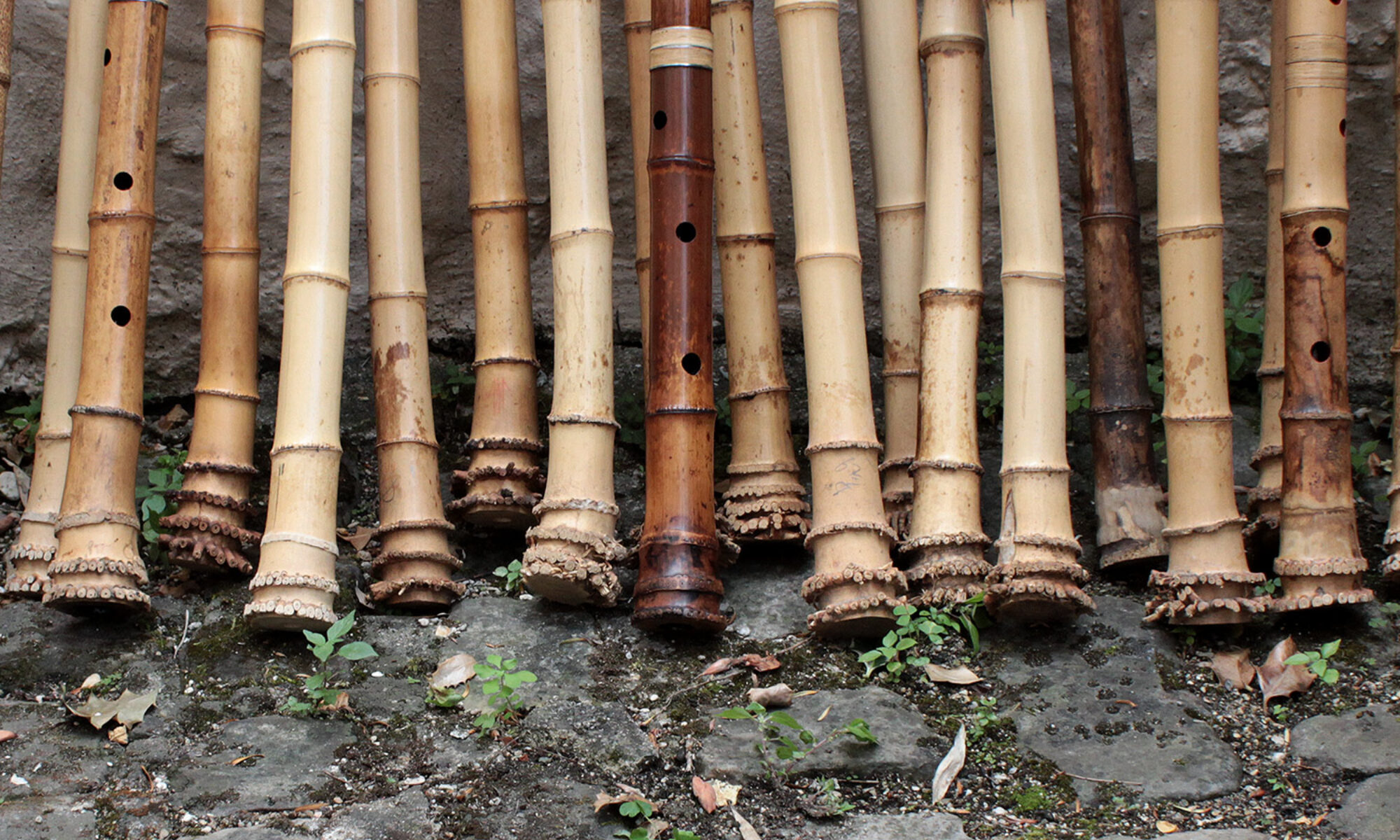A BRIEF HISTORY
It is widely believed now that the shakuhachi was first introduced into Japan around the end of the 7th century, originally forming part of the gagaku (court) ensemble and then evolved through a series of modifications, to reach its present form during the 17th century.
During the Edo period of Japanese history (1603 to 1868), shakuhachi playing monks formed the Fukeshū or Fuke sect, a subsect of the Rinzai Zen sect. These komusō or ‘priests of nothingness’ saw the shakuhachi as a spiritual tool and used it as part of their spiritual exercises, sometimes referred to blowing zen or suizen by some people today, (although the term of suizen is nowadays pretty conclusively seen by scholars as a creation of the mid-20th century), as well as using it for religious begging for food. The wandering monks moved around from temple to temple associated with the Fuke sect, and in turn learning and exchanging the local repertoire of pieces found at each of the various temples spread out all over Japan during this time. An approximately 77 Fuke temples did exist during this period. The honkyoku (本曲; original sound or music) repertoire evolved through this exchange and there are about 150 pieces now associated with this period.
After the Edo period a secularisation process started under the new Mejii government (1868-1912), which also affected the komusō monks and led to the disappearance of their sect. The shakuhachi world, as many other japanese art disciplines, started to organise itself into schools or guilds (ryūha), and sometime in the 18th century KINKO Kurosawa, a komusō monk collected 36 honkyoku of the Fukeshū from various temples. He also made improvements to the instrument turning it into the modern shakuhachi.
His school or style of shakuhachi (‘Kinko School’ or Kinko-ryū) eventually became one of the two major schools of shakuhachi in Japan today. The other is the later Tozan-ryū, founded by TOZAN Nakao (1876-1956) in 1896. In addition there are numerous smaller schools, styles and sub-groups of the main groups, e.g. Ueda-ryū , Chikuhō-ryū (both founded in 1917).
More recent schools include the Kokusai Shakuhachi Kenshūkan (KSK) founded by YOKOYAMA Katsuya in 1988), as well as Zensabō (OKUDA Atsuya), Kifu-kai (MITSUHASHI Kifu) or Hijiri-kai (FUKUDA Teruhisa) to name just a few.
The 1960s can be seen as very important decade for the developement of the shakuhachi and its expansions into the West and western conciousness.
Often regarded as a pivotal moment of the shakuhachi’s arrival in the West was TAKEMITSU Toru’s composition November Steps. It was commissioned and premiered by the New York Philharmonic Orchestra in November 1967 and featured YOKOYAMA Katsuya on shakuhachi and TSURUTA Kinshi on the biwa and with its juxtapositions of western orchestra and eastern (japanese) instruments put the shakuhachi and its sound and tonal qualities firmly on the map.
Another influential japanese master player was YAMAGUCHI Goro (Kinko-ryū/Chikumeisha). When being Artist in Residence at Wesleyan University in Connecticut (USA) between 1967/68 he recorded the LP A Bell Ringing in the Empty Sky (Nonesuch Records, 1969) which was the first of traditonal shakuhachi honkyoku music recording to be released in the US. (YAMAGUCHI ‘s performance of Tsuru no Sugumori (Nesting Cranes) eventually was included as one of the music recordings chosen for Voyager Golden Record which is onboard the spacecrafts Voyager 1 & Voyager 2 launched by NASA in 1977)
YAMAMOTO Hozan (Tozan-ryū) was also very active in crossover projects with western musicians and recorded among many others Music for Zen Meditation (and other Joys) with American jazz clarenetist Tony Scott and Silver World with American jazz double bassist Gary Peacock.
In Japan itself the YAMAMOTO Hozan, AOKI Reibo (Kinko-ryū/Reibo-kai) and YOKOYAMA Katsuya (Chikushinkai/KSK) formed the acclaimed Shakuhachi Sanbon Kai trio in 1966 with the aim to commission and perform new repertoire for the instrument. (e.g. Fudo I-IV by KINEYA Seiho, 1965 onwards)

Over the next four decades the shakuhachi increased its presence outside of Japan, with a growing amount of western shakuhachi players learning the various traditional repertoires as well as the increasing use of the instrument within jazz, improvisation and contemporary music contexts or on popular film soundtracks. Shakuhachi sounds have also been extensively sampled and used within pop music, most notably and earliest probably in the intro of Peter Gabriel’s hit ‘Sledgehammer’ (1986).
Since 1994 an International or World Festival is held approximately every four years. The first World Festival was initiated by YOKOYAMA Katsuya and was held in Bisei, Okayama Prefecture, Japan. The concept that many of the top players from diverse backgrounds, styles and guilds in shakuhachi, koto and shamisen (accompanying japanese string intruments for ensemble music) get together and perform and therewith transcend the historic segmentation often found within the traditional arts in Japan, was a new concept and one of the major motivations behind founding an international and cross-school festival. Subsequently the World Shakuhachi Festival took place in Boulder, USA (1998), Tokyo, Japan (2002), New York, USA (2004), Sydney, Australia (2008), Kyoto, Japan (2012) and most recently in London in 2018. The subsequent WSF to be held in Chaozhou, China (2022) was cancelled due to the covid pandemic. The next WSF is scheduled for 2025 and will be held at A&M University in Texas.
